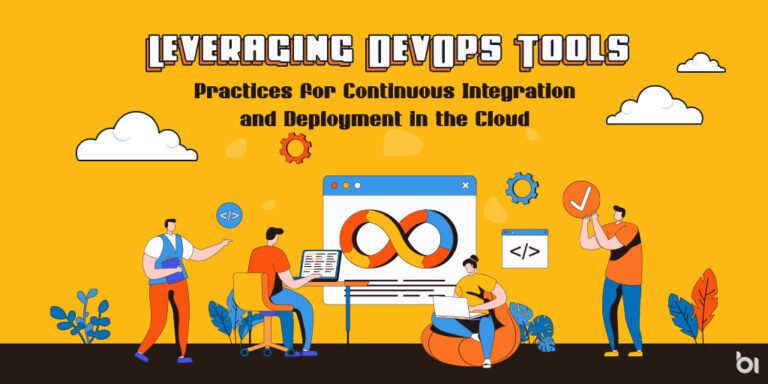One of the key benefits of using Leveraging DevOps tools and methods is the ability to perform continuous integration and deployment in the cloud. Continuous integration is the process of integrating code updates into a shared repository.
This lowers the chance of conflicts, enables early problem detection and correction, and raises the overall quality of the software. Continuous deployment is the process of immediately deploying tested and approved code changes to production. This enables businesses to provide clients with new features and upgrades more quickly and regularly.
In this article, we’ll talk about how DevOps tools and techniques can help with cloud-based continuous integration and deployment. For these goals, we will also give examples of well-known DevOps tools.
Additionally, we’ll go over some best practices for implementing DevOps in the cloud and talk about some of the difficulties and considerations to keep in mind for businesses.
Our final section will explore case studies of businesses that have effectively used DevOps in the cloud and provide some insights from their experiences.
Leveraging DevOps Tools: Practices for Continuous Integration and Deployment in the Cloud
Continuous Integration in the Cloud
The concept of continuous integration is essential for assuring the dependability and quality of software. It involves automatically building, testing, and deploying the code whenever changes are made as well as often integrating code updates into a shared repository.
This lowers the chance of conflicts, enables early problem detection and correction, and improves the overall quality of the software.
Continuous integration in the cloud can be supported in a number of ways by DevOps tools and practices. The development, test, and deployment processes can be first automated, which will make them faster and more reliable.
Tools like Jenkins, Travis CI, and CircleCI, which offer a continuous integration platform that can be easily integrated with cloud environments, can be used to accomplish this.
Second, DevOps tools and practices can support collaboration and communication among developers, which is essential for successful continuous integration.
Continuous Deployment in the Cloud
Continuous deployment is the process of automatically releasing code changes and approved code changes to production. This enables businesses to provide clients with new features and upgrades more faster and frequently.
DevOps tools and practices can be supported in a number of ways by DevOps tools and practices. The release process can be automated, making it faster and more reliable.
Tools like Spinnaker, AWS CodePipeline, and Azure DevOps, which offer a continuous deployment platform that can be easily integrated with cloud environments, can be used to accomplish this.
Second, DevOps tools and practices can support the management of many environments, including development, staging, and production, which DevOps tools and techniques can assist.
Tools like Ansible, Terraform, and CloudFormation, which offer infrastructure as code (IaC) capabilities that enable enterprises to define and manage their cloud infrastructure in a versioned and automated way.
Third, DevOps practices and tools can allow deployment monitoring and logging, which is crucial for detecting and fixing issues as well as ensuring the dependability and performance of the software.
Tools like New Relic, Datadog, and Splunk, which offer monitoring and logging capabilities that can be easily integrated with cloud environments.
Best Practices for Implementing DevOps in the Cloud
When deploying DevOps in the cloud, enterprises should adhere to a number of best practices. These consist of:
Planning and organization are crucial for the successful implementation of DevOps in the cloud, and to involve all relevant stakeholders in the process. This entails defining the DevOps transformation, objectives, and benefits as well as the resources, skills, and technologies required.
Version control and code management: In order to manage the codebase, a strong and scalable version control system must be in place. Likewise, follow best practices while merging, branching, and releasing code. Version control and code management features may be easily integrated with cloud environments thanks to tools like Git, GitHub, and Bitbucket.
Testing and quality assurance: It is important to have a robust and scalable testing and quality assurance process in place to ensure the reliability and performance of the software. This includes unit testing, integration testing, and acceptance testing, as well as the use of tools such as Selenium, Appium, and JMeter for automated testing.
Monitoring and logging: In order to detect and fix issues, it’s critical to have a reliable and scalable monitoring and logging system in place. also to guarantee the performance and dependability of the software. Monitoring and logging capabilities may be easily integrated with cloud environments using tools like New Relic, Datadog, and Splunk.
Challenges and Considerations
When using DevOps tools and implementing DevOps on the cloud, organizations must take into account a number of challenges and considerations. These consist of:
Security and compliance: It’s crucial to make sure that the applications and cloud infrastructure are both secure and compliant with all relevant regulations and standards. In addition to using technologies like Security Hub, GuardDuty, and Inspector for security monitoring and compliance, this also includes the adoption of security best practices including encryption, access control, and vulnerability management.
Resource management and cost optimization: It is crucial for reducing expenses and maximising efficiency while using cloud resources. This includes using cost-saving techniques like reserved instances, spot instances, and auto scaling as well as monitoring and optimizing resource utilisation using tools like CloudWatch, CloudTrail, and Cost Explorer.
Collaboration and communication: It should be encouraged between all stakeholders, including the developers, operations, and business teams. Slack, JIRA, and Trello, among other collaboration and communication platforms, can help with this. by adhering to agile principles, which include regular meeting, short feedback loops, and continuous improvement.
Case Studies
There are many examples of companies that have successfully Leveraging DevOps Tools in the cloud and achieved significant benefits. Some examples include:
Netflix: Netflix is a pioneer of DevOps in the cloud, and has used a combination of tools and practices to support its continuous delivery model. These include the use of Amazon Web Services (AWS) for its cloud infrastructure.
And the use of tools such as Jenkins, Spinnaker, and Chaos Monkey for automation and resilience. As a result, Netflix has been able to deliver new features. And updates to its customers faster and more frequently, and to scale its operations efficiently.
Etsy: Etsy is an e-commerce company that has used DevOps principles and tools to improve the reliability and performance of its platform. These include the use of AWS for its cloud infrastructure. And the use of tools such as Jenkins, Puppet, and New Relic for automation and monitoring.
As a result, Etsy has been able to reduce the mean time to recovery (MTTR) of its platform. And to deliver new features and updates to its customers faster and more frequently.
Spotify: Spotify is a music streaming company that has used DevOps principles. And tools to improve the reliability and performance of its platform.
These include the use of AWS for its cloud infrastructure. The use of tools such as Jenkins, Ansible, New Relic for automation and monitoring. As a result, Spotify has been able to reduce the MTTR of its platform. And to deliver new features and updates to its customers faster and more frequently.
Conclusion
In conclusion, Leveraging DevOps tools and practices can support continuous integration and deployment in the cloud. And provide significant benefits to organizations. These include the ability to deliver new features and updates to customers faster. And more frequently, to improve the quality and reliability of the software, and to optimize the use of cloud resources.
When Implementing DevOps in the cloud, it’s crucial to adhere to best practises and address problems. For example, making sure of security and compliance, maximizing cost and resource management, and fostering cooperation and communication.
by learning things from companies that have successfully implemented DevOps in the cloud. The odds of an organization succeeding and achieving its goals can be increased.




